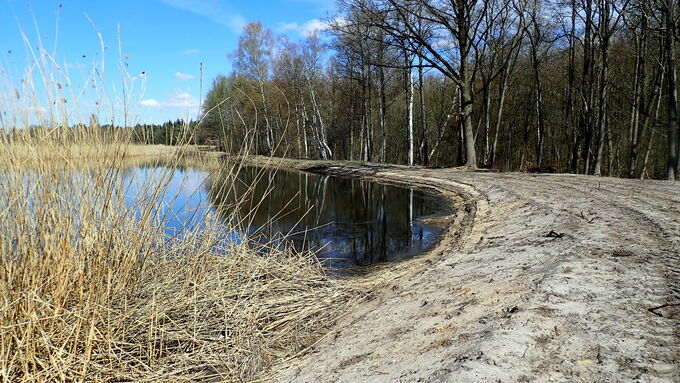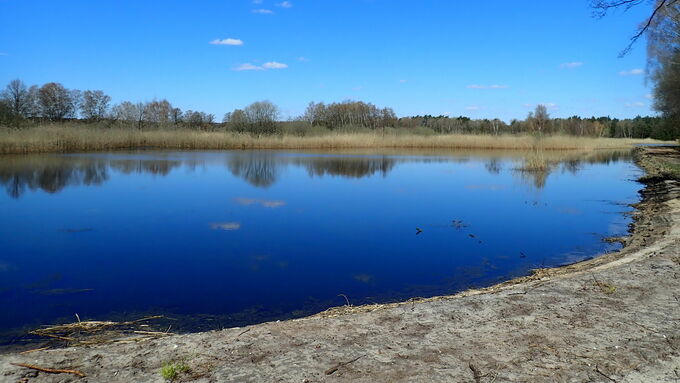At this point, the dam had broken. Within the framework of the LIFE IP Atlantic Region DE, the breach was closed so that the pond system regained its water holding capacity. © Kristof Meyn, NLWKN
main content
Project of the month
#02/2022 FISH FARMING ‘HOLMER TEICHE’
Conservation of spadefoot toad spawning waters and expansion of LRT 3130 in the FFH area Lüneburger Heide
The Holmer pond system in the district of Harburg, which is managed by Stiftung Naturschutzpark Lüneburger Heide (Lüneburg Heath Conservation Area Foundation), is a biological hotspot within the SAC and nature reserve ‘Lüneburger Heide’. It is home to an abundance of species, including the spotted darter (Sympetrum depressiusculum, Red List of Lower Saxony category 1), shoreweed (Littorella uniflora, RL cat. 2), pillwort (Pilularia globulifera, RL cat. 2), white-tailed eagle (Haliaeetus albicilla, RL cat. 2), and osprey (Pandion haliaetus, RL cat. 2). The pond area is partially mapped as habitat type ‘oligotrophic to mesotrophic standing waters with vegetation of the Littorelletea uniflorae and/or of the Isoeto-Nanojuncetea’ (habitat type 3130). In addition, some of the ponds serve as spawning waters for the common spadefoot (Pelobates fuscus).
In August 2020, the dam of a feeding pond near the adjacent district road broke. The breach of the dam at the edge of the pond area threatened both the habitat type and the reproduction of the common spadefoot by limiting the water retention capacity of the entire area. Therefore, there was an urgent need for action: The broken dam had to be closed as soon as possible in order to exclude a threat to the pond ground vegetation by more competitive species and to keep the spawning waters functional. The low competitiveness and light demands of the species of the Littorelletea uniflorae and/or of the Isoeto-Nanojuncetea require the presence of unshaded littoral zones with low competition from taller and more competitive species. Littoral zones with raw soil pioneer sites are also beneficial. In secondary, man-made occurrences in extensive pond farms, these conditions are achieved by draining and re-damming. In Lower Saxony, this habitat type is strongly dependent on functioning and used pond farms.
In the course of the reconstruction of the broken dam, further dams in the area were strengthened in order to eliminate weak points. In addition, parts of the soil in ponds which had fallen dry were removed in order to reactivate the seed banks of the pond ground vegetation and thus to preserve the habitat type 3130. However, this was not the end of the restoration measures: Ten concrete pond risers were purchased to replace dilapidated wooden pond risers. These are adjustable structures which are used to regulate the water levels in individual ponds. The pond ground vegetation of the habitat type 3130 depends on this type of regulation.
Related topics
- Overall objectives of the project
- Habitat type 3130 (in German)
- Species profile Common spadefoot (Pelobates fuscus)





